
This is an approach that is used in sports but it can be applied in other fields. It involves doing your best to improve the percentage chances of success.
Imagine that you want to follow this approach in your own work. You may be aiming to facilitate a mentoring session, run a project, lead a team, transform a culture or do another activity.
Let’s assume that in this instance you are going to be leading a team which needs to deliver a particular project. Before applying for the role you did your due diligence.
You began by doing lots of research. Bearing in mind what you would be able to control, you rated the percentage chances of achieving success as 70% Plus. This led to you taking the next steps.
You Set Things Up To Succeed
You met with the key stakeholders and made clear contracts about: a) the results to achieve; – the picture of success; b) the support required; c) the things you would do to proactively keep them informed.
You then clarified the key strategies you coould follow to achieve the picture of success. You also rehearsed following these strategies and managing any challenges along the way.
You also put the right people in the right places in the team. You also made clear contracts with each of them about their best contributions towards achieving the picture of success.
Let’s assume that you have taken these steps. You have begun the work and got some idea of the reality facing the team. Bearing these factors in mind, you may explore the following themes.
You Can Clarify The Present
Percentage Chances Of Success
Imagine that you have been leading the team for several months. The team has got some early successes and the work seems to be going reasonably well.
There may have been some events, however, that could begin to affect the team’s performance. These could include some of the following:
Changes in the market – such as new competitors arriving and being able to move quicker that your company;
Changes in personnel – such as your manager, who was a key backer, moving on and being replaced by somebody who is an unknown quantity;
Changes in financial conditions – such as your organisation cutting costs and creating uncertainty;
Changes in your team – such as some people not performing as expected or some leaving for personal or other reasons;
Changes in other things you can’t control – such as key customers leaving or changes in technology that are embraced by your competitors but not by your company.
Bearing these factors in mind, you can do a new reality check. Some of the findings may be challenging but you can then move towards finding solutions. You may want to explore the following questions.
How high would I rate the present percentage chances of achieving success?
Try to be as objective as possible when answering the question. Once you have given a percentage rating, then answer the following question.
What are some of the reasons why I have given this present percentage rating?
Imagine you have listed these reasons. Although you will get into more detail in the next section, it can be good to begin to lift your spirits by starting to explore the follow question.
What are the things we can do to maintain or improve the percentage chances of success?
Let’s assume that you have explored these questions. It will then be time to move on to the next stage.
You Can Clarify How To Improve
The Percentage Chances Of Success
Imagine that you have rated the chances as 70%. Bearing in mind what you can control in the situation, you can then brainstorm ideas under the following heading.
The specific things we can do to improve
the percentage chances of success are:
To …
To …
To …
Dare to describe lots of ideas – even those that may seem improbable. You can then move on to being selective and focusing on the actions you believe in.
As a leader, you may be able to implement some of these ideas without consulting with your key stakeholders but there may be others where you need their backing. Here are some of the ideas you may brainstorm.
We can aim:
To get some more quick success stories to show what is working and then go to our stakeholders to get more backing;
To be more selective by focusing on the specific areas where we stand the greatest chance of success rather than by spreading our resources too thinly;
To make changes in the team that will increase the chances of us achieving success;
To focus on the practical things we can do to build on what we can control and manage some of the things we can’t control;
To produce several potential strategic options for going forwards – together with the pluses and minuses of each option – such as:
a) to pursue our present strategy with either our present resources, with added resources or fewer resources;
b) to pursue a more selective strategy – such as focusing on certain specific targets – and in this way improving the chances of success;
c) to pursue a potentially different strategy that builds on our strengths and will stand a good chance of achieving certain successes.
d) to meet the key stakeholders to outline the potential options – together with the pluses and minuses of each – plus any other options they can suggest and agree with them on the route going forwards.
Let’s assume that you have explored the various options. This takes you to the next stage.
You Can Do What You Can To
Improve The Chances Of Success
You may then take time to see the big picture and consider the potential options going forwards. Looking ahead, you may believe that, providing you and the team do your best, there is still a good chance of achieving success.
You can then am: a) to focus on the potential actions that lie within your area of autonomy; b) to have translate some of these into action and get some early successes. This will create positive momentum.
You may then work with the team to keep focusing on the things that are in the Green, Amber and Red Zones. This will involve people doing the following exercises.
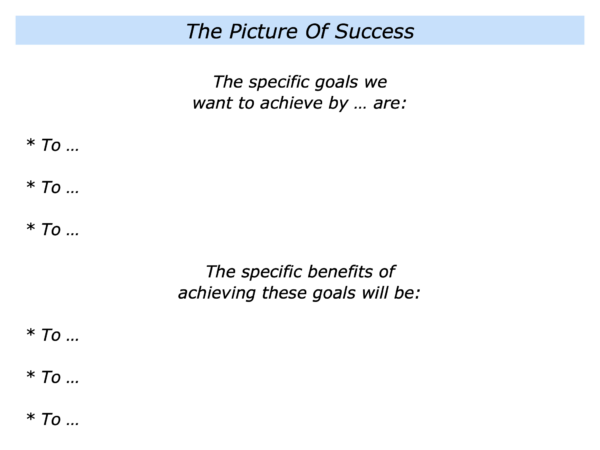
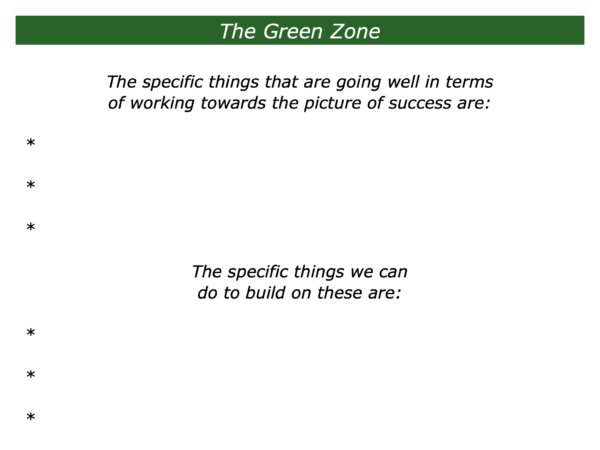
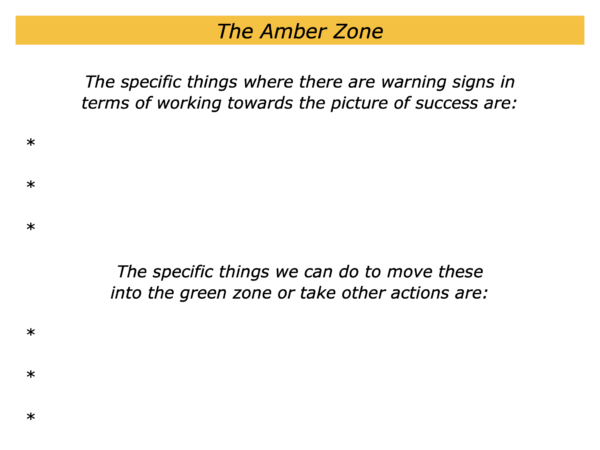
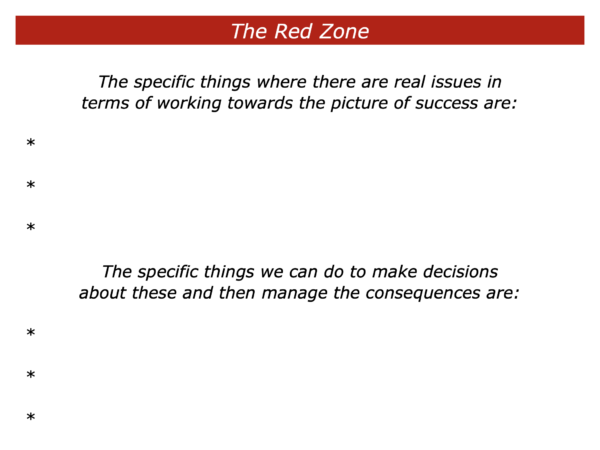
Imagine that the team is doing superb work but there are still challenges. Some of these may be surmountable but others may pose more existential threats.
You can again rate the team’s percentage chances of success and how to improve the chances. But you may reach a point when there needs to be a more radical appraisal.
You may look at the big picture and consider the possible ways forwards. This may lead to preparing to have a one-to-one session with your key stakeholder – the person who can make executive decisions. The stakeholder may want you to brief them ahead of time, however, because they may not like surprises.
Bearing this in mind you can prepare properly. This will involve giving the context and aiming:
To revisit the original picture of success and the benefits to the company;
To give an update on the successes so far and the potential challenges;
To outline the possible ways forward – together with the pluses and minuses of each option;
To invite the stakeholder to add any other possible options and, if they ask you, to offer your recommendations;
To invite the stakeholder to consider which route they would like you and the team to take in the future.
It will be vital to present this in a professional way – as if you were an outside consultant – and focus on what may be best for the company. It important to take this approach rather than get into fights.
The stakeholder may agree to following one of the options that you believe in. Or they may produce one that you feel it is possible for you to pursue. You can then focus on how to implement the strategy.
Let’s anticipate a potential difficulty. What happens if the stakeholder insists on pursuing a route that you may not believe in? It can then be useful:
To stay calm, listen and show you understand what they are saying;
To buy time to think and, in a professional way, say you want to explore the possibility;
To finish the meeting in a positive way and say when you will get back to them with a plan.
Taking time to reflect, you can consider your possible options going forward. Looking at each of the options, you can clarify the pluses and minuses for you personally and for the team. The options may include the following:
To go with what the stakeholder suggests;
To build on some of the positives in the suggestion and find ways to manage the minuses;
To offer another possible route – or combination of routes – to the stakeholder and outline the benefits to the company;
To decide to move on from the role because you no longer believe it is possible to do satisfying work or achieve success;
To suggest other possible ways forwards.
Imagine that you have explored all these options and have made a decision. Whatever route you choose to go, it will be important to behave in a professional way.
You may choose to stay in the role and do your best to increase the chances of success. You will have taken this decision as a responsible adult, however, and not by choosing to be a victim.
Alternatively, you may choose to move on. If so, you may aim to do this in a way that creates, as far as possible, wins for you, for your family and for the company.
There are many ways to do fine work. One approach is to do your due diligence. It is then to set thing up to succeed, do superb work and keep focusing on how to increase the percentage chances of success.
Here we have explored how to take these steps when leading a team. The approach can be applied in other situations, however, such as when working as an individual. It can also be adapted to aspects of your personal and professional life.
Let’s return to your own life and work. Looking ahead, can you think of a specific situation where you may want to improve the percentage chances of success? How can you do this in your own way?
If you wish, try tackling the exercise on this theme. This invites you to complete the following sentences.
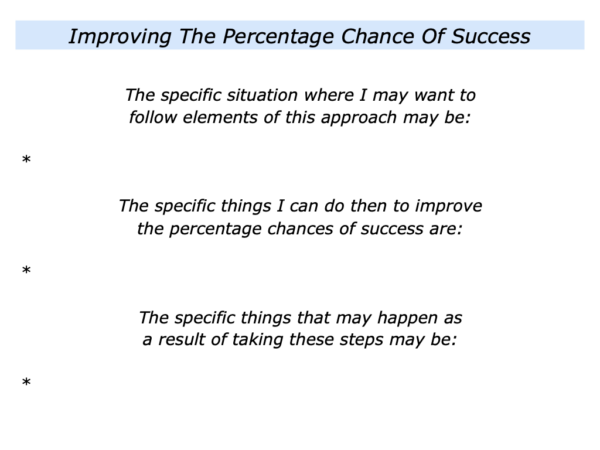






Leave a Reply